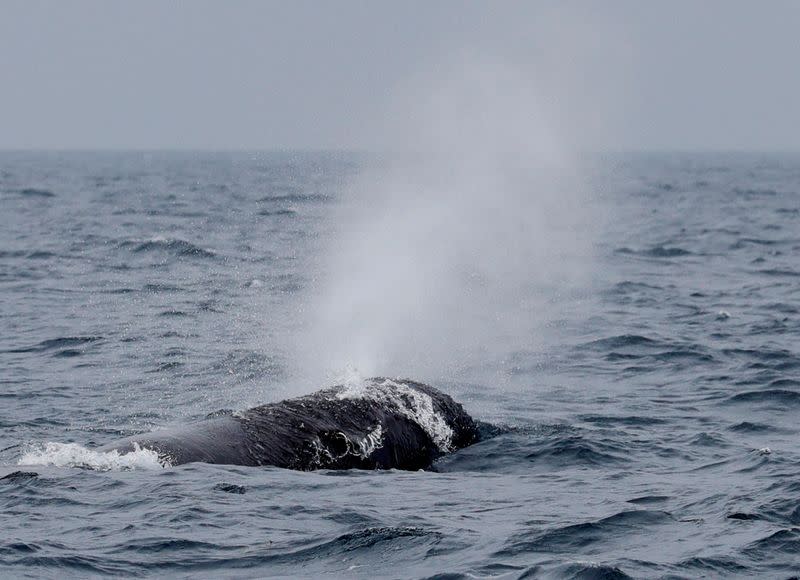Scientists document remarkable sperm whale 'phonetic alphabet'
By Will Dunham
(Reuters) - The various species of whales inhabiting Earth's oceans employ different types of vocalizations to communicate. Sperm whales, the largest of the toothed whales, communicate using bursts of clicking noises - called codas - sounding a bit like Morse code.
A new analysis of years of vocalizations by sperm whales in the eastern Caribbean has found that their system of communication is more sophisticated than previously known, exhibiting a complex internal structure replete with a "phonetic alphabet." The researchers identified similarities to aspects of other animal communication systems - and even human language.
Like all marine mammals, sperm whales are very social animals, with their calls an integral part of this. The new study has provided a fuller understanding of how these whales communicate.
"The research shows that the expressivity of sperm whale calls is much larger than previously thought," said Pratyusha Sharma, a Massachusetts Institute of Technology doctoral student in robotics and machine learning and lead author of the study published on Tuesday in the journal Nature Communications.
"We do not know yet what they are saying. We are studying the calls in their behavioral contexts next to understand what sperm whales might be communicating about," said Sharma.
Sperm whales, which can reach about 60 feet (18 meters) long, have the largest brain of any animal. They are deep divers, feeding on giant squid and other prey.
The researchers are part of the Project CETI (Cetacean Translation Initiative) Machine Learning Team. Using traditional statistical analysis and artificial intelligence, they examined calls made by about 60 whales recorded by the Dominica Sperm Whale Project, a research program that has assembled a large dataset on the species.
"Why are they exchanging these codas? What information might they be sharing?" asked study co-author Shane Gero, Project CETI's lead biologist and Dominica Sperm Whale Project founder, also affiliated with Carleton University in Canada.
"I think it's likely that they use codas to coordinate as a family, organize babysitting, foraging and defense," Gero said.
Variations in the number, rhythm and tempo of the clicks produced different types of codas, the researchers found. The whales, among other things, altered the duration of the codas and sometimes added an extra click at the end, like a suffix in human language.
"All of these different codas that we see are actually built by combining a comparatively simple set of smaller pieces," said study co-author Jacob Andreas, an MIT computer science professor and Project CETI member.
People combine sounds - often corresponding to letters of the alphabet - to produce words that carry meaning, then produce sequences of words to create sentences to convey more complex meanings.
For people, Sharma said, "There are two levels of combination." The lower level is sounds to words. The higher level is words to sentences.
Sperm whales, Sharma said, also use a two-level combination of features to form codas, and codas are then sequenced together as the whales communicate. The lower level has similarities to letters in an alphabet, Sharma said.
"Every communication system is tailored to the environment and animal society in which it has evolved," Sharma added.
The communication system used by sperm whales differs, for example, from the "songs" of humpback whales - and, for that matter, from the whistles, chirps, croaks and assorted other vocalizations by various animals.
"Human language is unique in many ways, yes," Gero said. "But I suspect we will find many patterns, structures and aspects thought to be unique to humans in other species, including whales, as science progresses - and perhaps also features and aspects of animal communications which humans do not possess."
If scientists can decipher the meaning of what the sperm whales are "saying," should people try to communicate with them?
"I think there's a lot more research that we have to do before we know whether it's a good idea to try to communicate with them, or really even to have a sense of whether that will be possible," Andreas said.
"At the same time, I'm optimistic that we're going to be able to learn a lot more about what information is actually encoded in these vocalizations that we're listening to, what sort of information is contained in these clicks and these codas, as we start to understand the behavioral context in which this occurs," Andreas added.
(Reporting by Will Dunham in Washington; Additional reporting by Matthew Stock in London; Editing by Rosalba O'Brien)



